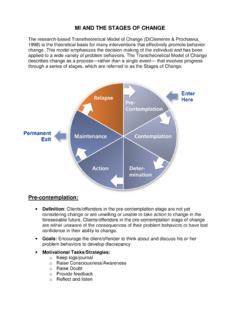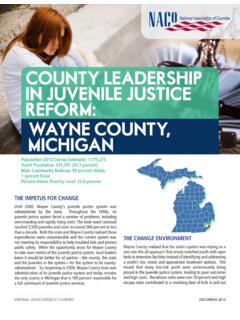Transcription of Statewide Evaluation of the DCJ Juvenile Diversion Program
1 Statewide Evaluation of the DCJ Juvenile Diversion Program Submitted to The Colorado Division of Criminal justice June 2013 Statewide Evaluation of the DCJ Juvenile Diversion Program For more information, please contact: Chandra Winder, MPA 303-839-9422 x167 Jean Denious, PhD 303-839-9422 x121 For General Inquiries/Questions p. 303-839-9422 f. 303-839-9420 A c k now ledgements: This project was supported by Award number 2011-JF-FX-0025 awarded by the Office of Juvenile justice and Delinquency Prevention, Office of justice programs through the Division of Criminal justice , Colorado Department of Public Safety.
2 The opinions, findings, and conclusions or recommendations expressed in this publication are those of the author(s) and do not necessarily reflect the views of the Department of justice nor the Division of Criminal justice , Colorado Department of Public Safety. OM N I Contr ibu tors: Joy Collins, MSS; Rashaun Esposito; Jeremy Kazanjian-Amory, BA; Rochelle McCauley, MPH; Danielle Olds, BA; Jennifer Shepherd, PhD OMNI Institute 899 Logan Street, Suite 600 Denver, CO 80203 Table of Contents 1 Evaluation Design .. 3 Methods .. 4 Data Collection Tools and Sources.
3 4 Analysis .. 5 Results .. 6 Who is Served by Diversion ? .. 6 What Services Are Provided?.. 10 Are Minority Youth Adequately Represented In Diversion ? .. 20 Do programs Impact Short- And Long-Term Outcomes? .. 22 Are Changes In Short-Term Outcomes Associated With Reduced Recidivism? .. 25 26 Program Impacts On Short-Term Outcomes And 26 Provision And Funding Of Services .. 27 28 29 Appendix A:Research Questions ..I Appendix B: Protocols for Data VIII Appendix C: Intake/Exit Form and Instructions .. XI Appendix D: Pre-Post Survey and Instructions ..XVIII Appendix E: Descriptive Data.
4 XXIII Appendix F: Intake Data .. XXV Appendix G: Exit Prepared by OMNI Institute i Executive Summary Background As part of its Adult and Juvenile justice Assistance programs , the Division of Criminal justice (DCJ) funds the Juvenile Diversion grant Program . Created by Colorado state statute, the grant Program is intended to divert youth from penetrating further into the Juvenile justice system. While Diversion can occur at multiple stages of the Juvenile justice system and be offered to youth with varying levels of offense, DCJ primarily funds services for youth who are pre-file or pre-adjudicated and who have committed a district level offense.
5 In order to better understand the services and outcomes of its grant Program , DCJ contracted with OMNI Institute in 2010 to develop and implement a Statewide Evaluation of its 19 funded Juvenile Diversion programs . The overarching aim of the Statewide Evaluation is to allow providers, state agencies, and other stakeholders to make more informed decisions and improve the provision of services. The Evaluation comprises examination of 19 different programs , each offering a unique set of services that are further tailored to each youth within the Program . The Evaluation design encompasses multiple measures and data sources to address four key question areas: 1.
6 Who is served by Diversion ? 2. What services are provided? 3. Are programs /services effective? 4. What youth and Program factors are associated with (reduced) recidivism? Multiple measures and data sources were utilized to ensure a comprehensive understanding of: the population served, the services and programming provided, short-term outcomes, and recidivism; and the relationships among these variables. The figure below provides a visual representation of the core data elements in the fashion of a logic model. Complex multi-level models were employed to examine relationships among services, short-term outcomes, and recidivism while statistically controlling for variability in services and youth characteristics across programs .
7 Ii Diversion Evaluation Logic Model iii Who is Served by Diversion ? Di version programs served 1,323 youth across Colorado during years of data collection; and 708 youth across Colorado during the state fiscal year 2011-12. Pr ograms differed greatly in the numbers of youth served with some programs serving around 175 youth and others serving fewer than 50 youth. O n average, youth were 15 years old at the time of intake into Diversion . The ma jority of youth participating in Diversion were male and over half of Diversion pa rticipants were White, non-Hispanic ; just under a third (32%) of participants were identified as Hispanic or Latino.
8 African American participants comprised only 2% of the entire sample. White youth were 5 times more likely than African-American youth to be represented in Diversion programs , based on the arrest numbers for the 15 judicial districts represented in DCJ-funded Diversion programs . iv What Services are Provided? Data were collected on 25 specific services with a 26th category of other for any services provided that were not already described. These 25 services were grouped into five categories: Supervision, Treatment, Accountability, Restorative justice , and Competency services.
9 The graph below depicts the proportion of youth that received at least one service in each of the categories. The full report includes the number and proportion of youth receiving individual services within each category; as well as the provision (in-house versus referred out) and funding (DCJ or other) source. v Are programs /Services Effective? A l arge majority of youth (85%) successfully completed programming. Al l short-term outcomes showed statistically significant change in the desired direction f r om pre- to post- Program . This finding indicates that at an aggregate level, the selected short term outcomes are impacted by Diversion programs .
10 The individual short-term outcome score changes are displayed in the table below. CHANGES IN SHORT-TERM OUTCOMES Outcome Pre-Survey Mean Post-Survey Mean Desired Direction of Change? Significant? Connection to Community Yes Yes Decision Making Yes Yes Future Aspirations Yes Yes Self-Esteem Yes Yes Locus of Control Yes Yes Sense of Accountability Yes Yes Risky Behavioral Intentions Yes Yes RECIDIVISM RATES Colorado s standard criterion for recidivism is a filing or filings for a new offense either while the Juvenile was in the Program or up to one year after they exited the Program .



















